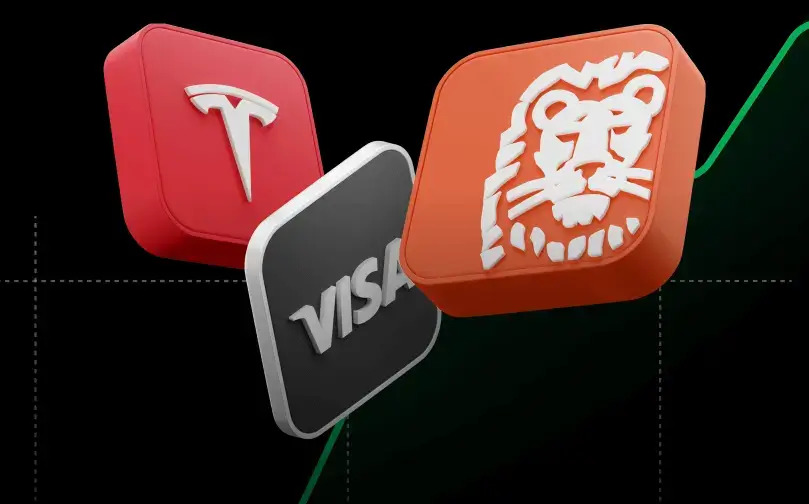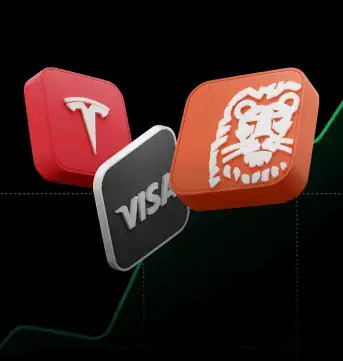Are you prepared to enter the realm of investment? Exchange-traded funds (ETFs) provide a versatile, diversified option for constructing an investment portfolio spanning various asset classes, including individual stocks, commodities, and precious metals. Within this guide, we will delve into the essence of ETFs, empowering you to select the most suitable options for your financial objectives. Prepare to dive in and explore a range of investments effortlessly through exchange-traded funds today!
Are you prepared to enter the realm of investment? Exchange-traded funds (ETFs) provide a versatile, diversified option for constructing an investment portfolio spanning various asset classes, including individual stocks, commodities, and precious metals. Within this guide, we will delve into the essence of ETFs, empowering you to select the most suitable options for your financial objectives. Prepare to dive in and explore a range of investments effortlessly through exchange-traded funds today!
Ready to get started in the world of investing? Exchange-traded funds (ETFs) offer a flexible, multi-faceted option for building out an investment portfolio across various asset classes, like individual stocks, commodities and precious metals. In this guide, we will discuss what ETFs are all about so that you can choose the right one(s) for your own financial goals. Get set to jump into learning more and unlocking diverse investments with ease through exchange traded funds today!
Key Takeaways
- Exchange-Traded Funds offer investors low costs, liquidity, and diversification.
- ETFs provide a combination of diversification, flexibility, cost savings and increased tax efficiency compared to mutual funds & individual stocks.
- To maximize returns with ETF investing, maintain a long-term perspective while rebalancing your portfolio & considering tax efficiency.
Understanding Exchange-Traded Funds

Exchange traded funds (ETFs) are investment vehicles that allow for the purchase and sale of instruments which represent a portfolio filled with various assets, such as stocks, bonds, or commodities. By investing in ETFs there can be advantages including low costs when compared to other forms of investments. Enhanced liquidity within an exchange traded fund is also provided, as well as diversification. When wanting to buy into this type of financial instrument it’s just like buying individual stocks on stock exchanges – making them appealing to both investors who know what they’re doing and those starting out too.
Before beginning your venture into Exchange-Traded Funds it would help understand some basics about these instruments along with their benefits available during investing activities.
The Basics of ETFs trade
When it comes to investing, ETFs are one of convenient trading options. They are traded on stock exchanges and the value of most is determined by underlying assets they represent, such as indices or stocks representing whole sectors, like technology and healthcare. Some ETFs are passively managed which mirrors an index’ performance while others have active management making investments in attempts at outperforming markets. To invest in them requires opening up a brokerage account (such as a trading account at XTB’s xStation trading platform), then researching options that match your investment aims then executing trades. These can be done during regular trading hours instead of only being possible after closing like with mutual fund transactions enabling more flexibility & control over decisions taken by investors.
Advantages of Investing in ETFs
Investing in Exchange-Traded Funds has several benefits, such as lower fees, enhanced tax effectiveness and the possibility to transact at any point during trading hours. When compared to mutual funds, ETFs have cheaper expense ratios making them a more cost-efficient and passive investing option for many investors. The taxation of these assets is significantly better than that of their counterpart. Intraday trading offers greater flexibility by enabling those investing with it to respond faster and benefit from short term market shifts in order to adjust their portfolios appropriately.

Exchange-Traded Funds work, for example, by tracking a specific index, such as the S&P 500, and holding a basket of assets that represent the underlying index. An ETF that tracks the S&P 500 will hold a portfolio of stocks that are included in the index. This allows investors to gain exposure to the stock market without having to buy individual stocks.

One of the primary advantages of ETFs is their lower cost. Compared to mutual funds, ETFs have lower expense ratios. This is because Exchange-Traded Funds are designed to be more efficient in terms of how they are managed and traded. Unlike mutual funds, ETFs have fewer capital gains distributions, which reduces the tax burden on investors.
Another advantage of ETFs is their flexibility. Exchange-Traded Funds can be bought and sold throughout the day, just like individual stocks. This allows investors to have more control over their investments and react to market changes quickly. ETFs are also accessible to investors of all levels. Diversification is another benefit of ETFs. As Exchange-Traded Funds track various instruments, for example a specific index, they hold a diversified portfolio of assets. For example, an ETF that tracks the S&P 500 will hold a portfolio of 500 different stocks. This diversification can help to reduce risk and provide more stable returns.
Comparing ETFs to Mutual Funds and Individual Stocks
Exchange-Traded Funds (ETFs) provide a unique set of advantages for investors, as they combine the diversification benefits found in mutual funds and the trading flexibility of individual stocks. Not only do ETFs offer these qualities, but also have cost savings associated with them, along with increased tax efficiency and more versatility when managing portfolios.
Let’s compare how Exchange-Traded Funds stack up against traditional mutual funds or investing directly into single stocks - firstly, due to their distinct structure, costs related to owning an ETF are relatively lower than those applicable on similar holdings such as shares bought through regular stockbrokers. Secondly, since fewer trades need executing due to pooled investments there is less paperwork involved which leads to greater taxation effectiveness compared to direct ownership in individual securities.
ETFs vs. Mutual Funds
Mutual funds and ETFs are both popular investment vehicles that can provide investors with a diversified portfolio. The key differences between the two include fees, trading structure, tax efficiency and management style. Exchange-Traded Funds have lower costs associated with them, as well as being tradable on an intraday basis throughout the day. Mutual fund acquisitions only occur when their net asset value (NAV) has been calculated at closing time of each trading session. Due to trades taking place in exchange markets rather than through issuing or redeeming shares by mutual fund companies – ETFs tend to be more tax-efficient too. On top of this there is also active versus passive management available for these investments - whereas ETF’s typically follow passively managed indexes/sectors which may not yield high returns compared to actively managed mutual funds where portfolio managers make decisions in hopes they will outperform market averages but come along higher fees, in turn making it more costly for many potential investors.
ETFs vs. Individual Stocks
When investing in individual stocks, ETFs provide greater diversification and higher tax efficiency while reducing costs. An Exchange Traded Fund allows investors to access a basket of assets rather than just one company, thus lowering the risk associated with single stock investment. When compared to buying stocks directly from companies or markets there are additional benefits offered by Exchange-Traded Funds such as:
- Lower cost - as they come without hefty commissions, you can save on trading fees;
- Enhanced liquidity – due to their exchange listing, this type of fund is easier and faster to buy and sell;
- Tax advantages – reinvested distributions paid out within an ETF may be eligible for deferred taxes until disposal. On the other hand though it’s important not to expect identical returns that would result from equity investments alone since these baskets tend more towards volatility dampening overall performance potential gains/losses balance.
Investing in ETFs: the right choice for you?
Exchange-Traded Funds can be a good choice for investors who are looking for a long-term investment, and investors who hold their investments for a longer period of time are more likely to see better returns. However, like any investment, there is always risk involved.
If you are considering investing in ETFs, there are several tips that can help you get started. The first step is to do your research. Look at most of the ETFs' performance history, expense ratio, and holdings. Consider your investment goals and risk tolerance to determine if the ETF is a good fit for your portfolio.
Once you have done your research, the next step is to choose the right broker. For instance, XTB, as a regulated broker, offers a large selection of instruments and competitive trading fees.

It is also important to diversify your portfolio. While most ETFs are already diversified, it is important to further diversify your portfolio by investing in different sectors and asset classes. This will help to reduce risk and provide more stable returns.
It is also important to monitor your investments. Keep an eye on your ETF investments and monitor their performance. Rebalance your portfolio as needed to ensure that your investments remain aligned with your investment goals.
Finally, be patient. ETFs are a long-term investment, and it is important to be patient and not make rash decisions based on short-term market fluctuations. Stick to your investment strategy and trust in the long-term potential of your investments.
CFDs on ETFs: an interesting alternative
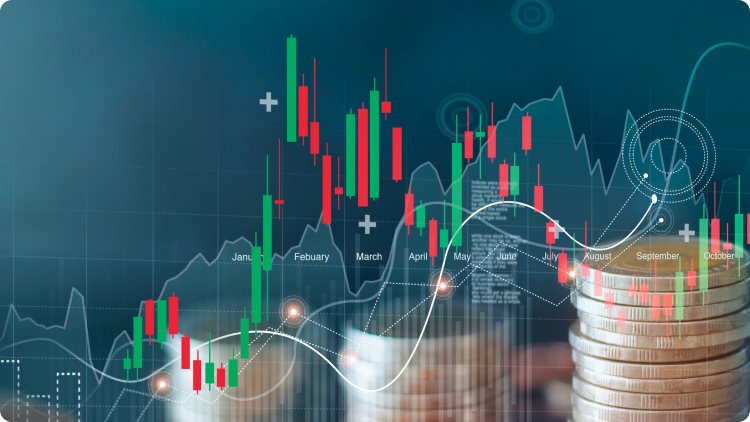
Here are some reasons why you might consider investing in CFDs on ETFs:
Diversification: Like ETFs themselves, ETF CFDs also provide access to a diversified portfolio of assets, as ETFs typically hold a basket of stocks or other underlying assets.
Flexibility: ETF CFDs are traded on margin, which means you only need to post a certain percentage of the total transaction value as collateral. This can provide more flexibility in your investment strategy, as you can potentially take on larger trades with less capital.
Leveraged Trading: ETF CFDs also allow for leveraged trading, which means you can potentially amplify your profits (or losses) by trading with borrowed funds. This can be a powerful tool for experienced traders, but it's important to remember that leveraged trading involves greater risk.
Lower costs: CFDs on ETFs often have lower transaction costs than trading the underlying ETFs themselves, which can help reduce your overall trading costs.
Of course, it is important to remember that trading ETF CFDs also carries risk and may not be the best option for everyone. It is important to do your research and understand the risks and potential rewards before investing in CFDs on ETFs or any other financial product. Additionally, you should consult a financial advisor or professional if you have any questions or concerns about your investment strategy.
Types of ETFs for Diversified Portfolios
For diversified investing, there are a range of ETFs to choose from. These include stock, bond, commodity and speciality funds which can be used to construct an investment portfolio tailored for your goals. From broad market access or specific opportunities – these exchange traded fund offerings cover all the bases when it comes to constructing an effective financial strategy.
Let’s delve deeper into how each type of ETF works together towards reaching desired objectives - creating the right balance between risk & return in terms of investments being made through these instruments is essential here.
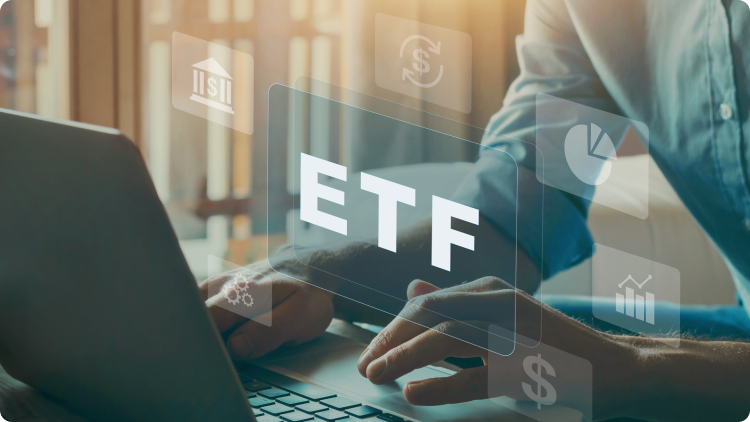
Stock ETFs
Stock ETFs are an excellent way to tap into market exposure or specific investment opportunities. These funds are often designed around indexes like the S&P 500, offering investors the opportunity to invest in large public companies in America. For instance, an ETF focused on technology could invest specifically within this sector.
Investing through stock ETFs can be cost-effective and efficient compared to actively managed investments. They usually carry lower fees while enabling you to diversify your portfolio into numerous different stocks using just one fund. With a platform like xStation at XTB, you can easily access a wide range of these ETFs, allowing you to tailor your investments to your specific financial goals and risk tolerance.
Bond ETFs
For investors seeking a more conservative approach or those desiring a steady income stream, Bond ETFs can serve as an excellent addition to their portfolio. These exchange-traded funds are grounded in underlying bonds such as corporate and government debt instruments - which are generally less volatile than equities – enabling a balanced diversification within investments while providing consistent returns. The fixed income securities offered by these ETFs present the potential for regular income payments, thus balancing out the turbulence of the stock market.
Commodity ETFs
ETFs that invest in commodities such as gold, oil, and agricultural products offer an alternative way to diversify portfolios while potentially providing protection from inflation. These ETFs enable investors to benefit from price movements without having actual ownership of a commodity itself.
Commodity ETFs can be a great tool for hedging against rising prices since commodity values tend to increase when the value of currency weakens. They provide excellent portfolio diversification because their prices usually fluctuate independently compared with those on stock or bond markets.
Speciality ETFs
Investment strategies like sustainable investing, currency hedging or a specific country exposure can be accessed through speciality ETFs. This is advantageous for investors to take part in distinctive market segments and pursue investment topics that are pertinent with their values or ambitions. Research should be done thoroughly to understand the distinct risks associated with these types of investments, as well as have an appropriate level of knowledge relating to them when compared against broader stock exchange ETFs.
How to get started with investing in ETFs

To get started with ETF investing, there are some straightforward steps to take: open a brokerage account, do research on the best ETFs for you based on your investment objectives and risk level of comfortability. After that, once you have taken all these steps, you can start investing in ETFs. By taking these measures into consideration it will make sure you have created a diversified portfolio suited specifically towards what’s important to you when it comes to financial investments.
Following this guide we’ll help show how easy getting into an invested position can be!
Researching and Selecting ETFs
Once you’ve opened a brokerage account, now is the time to choose your ETFs that match your investment goals and risk tolerance level. Using filters provided by brokers can be beneficial in narrowing down the options based on expense ratios, performance metrics and asset classes. Consider checking its trading volume which speaks for its liquidity levels when making purchases or sales of securities. It’s also essential to look into what type of underlying assets do they represent? What strategies does it follow? Is there an active management style implemented? Finally, review carefully their past performances keeping in mind future results might differ from historical records due to market changes over time but may give us clues as to how good they have been performing so far under different circumstances. If you’re confused with the selection or processing of your registered investment, advisors are available for help.
Placing an ETF Trade
Your ETFs are all set for trading, so it’s now time to go ahead and make your trades. Just like with individual stocks, you can purchase or sell shares of an ETF on any given day throughout the market session.
Before finalizing a trade involving an exchange traded fund (ETF), be sure to consider the different order types available such as: Market orders, Limit Orders, Stop orders & Stop-limit ones, these allow traders opportunities to buy at their desired prices plus manage potential risks more effectively.
Besides this point, it is also advisable that investors keep in mind associated costs which may come up from executing these transactions such as fees charged by brokerage firms and spreads between bid/ask prices since they have some influence on overall returns earned when engaging in investments/trades concerning ETFs.
Top ETF Picks for Beginners

Are you a newbie looking to begin investing in ETFs? To kickstart your investment portfolio, consider these top picks for coming years: low-cost index ETFs that track wide market indexes and industry or sector ETF which provide specific exposure. By adding this selection of budget friendly tools as the basis of your investments, they can help you reach whatever financial objectives have been set.
Low-Cost Index ETFs
For beginner investors, low-cost index funds are a great way to get broad exposure in the stock market with minimal costs. ETFs often track various major indexes, such as S&P 500 or Dow Jones Industrial Average, offering a cost-efficient means of investing in diversified portfolios of stocks. Investing in affordable index Funds can provide long term growth potential at manageable expenses, an advantage that no investor would want to miss out on!
Sector and Industry ETFs
Sector and Industry ETFs offer investors the potential for higher returns and diversification benefits. At xtb.com, you can explore a variety of sector-specific ETFs to align with your investment goals. Here are some relevant ETF options available at xtb.com:
- Technology Sector ETF: Consider investing in a technology sector ETF if you believe in the growth potential of tech firms. Explore options like Technology Select Sector SPDR Fund (XLK) available at xtb.com.
- Energy Sector ETF: If you are interested in advancements in medical services and treatments, you can explore an energy select sector ETF like Energy Select Sector SPDR Fund (XLE) at xtb.com.
- Financial Sector ETF: For exposure to the financial sector, you can consider the Financial Select Sector SPDR Fund (XLF), available at xtb.com.
By including these ETFs in your portfolio, you can tailor your investments to match your outlook and maintain a well-balanced exposure to specific sectors. xtb.com offers a range of industry and sector-specific ETFs to help you customize your investment strategy and potentially achieve your financial objectives.
Investors who carefully select industry and sector ETFs at xtb.com can aim for attractive rewards while investing their capital through diversified portfolios that align with their investment objectives.
Please remember that this marketing communication is intended for informational and educational purposes. It is not investment advice or information that recommends or implies an investment strategy. We do not propose any investment strategy nor provide any investment advisory in this material.
This material does not consider the client's personal financial situation, needs and investment objectives.
Tips for Successful ETF Investing

For a successful ETF investing experience, it is important to have an outlook that’s more oriented towards the long-term and to adjust your portfolio as needed. By doing this, you can maximize returns, minimize risk, and be better able to attain financial targets. To explore these insights, we will go into greater detail on how best one could approach ETF investments.
Long-Term Perspective
Investing in ETFs for the long haul is a great way to make your money work for you and take advantage of compounding returns. To be successful, it’s important to build an investment strategy before beginning investing – one that won’t waver due to short-term market fluctuations.
Portfolio Rebalancing
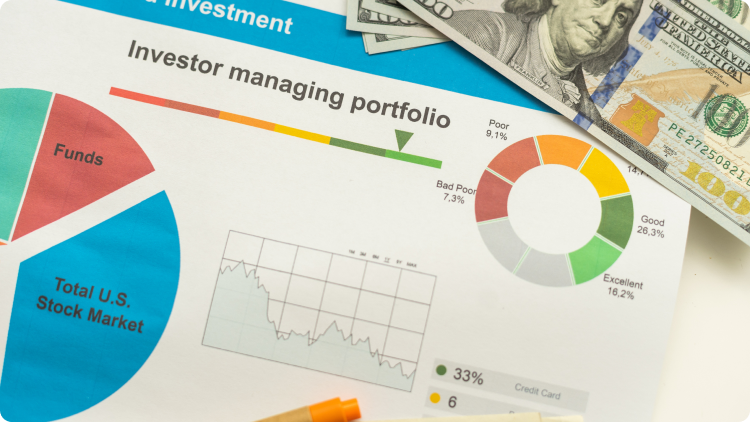
Periodically rebalancing your ETF investments is a critical aspect of successful investing. As the market evolves, you may find that your portfolio no longer reflects the asset allocation intended when you first set it up, possibly leading to greater risk than desired. Rebalancing allows for a strategic distribution across varied assets and sectors in order to minimize losses from unpredictable fluctuations in value. Developing an established schedule – such as once or twice each year – helps maintain adherence to investment goals going forward.
Tax Efficiency
When considering ETF investing, the tax implications need to be kept in mind for increased after-tax returns. On an exchange market, ETFs are known to provide more taxation advantages compared to other investment options such as mutual fund trades. By opting for this type of asset, you can potentially reduce your imposed taxes and maximize gains from investments.
Summary
ETFs provide a flexible and dynamic investing option, offering the diversification of mutual fund investments with the convenience of buying individual stocks. ETF choices range from lower cost index options to sector or industry specific ones, enabling investors to create a tailored portfolio that aligns with their financial objectives and risk appetite. To get started in this field you need to open an account at a brokerage firm, do your research into available ETFs then place trades accordingly - taking on board some sound advice such as having patience for long term results, regularly checking portfolio balance, and thinking about tax efficiency when making decisions can all assist you towards achieving successful investment returns eventually leading up towards ensuring your future prosperity!
FAQ
An ETF, or Exchange-Traded Fund, is a type of investment fund that holds a diversified portfolio of assets, such as stocks, bonds or commodities. ETFs are traded on exchanges, just like individual stocks, and are designed to track the performance of a specific index.
ETFs can provide a great way to get into investing with their diversification, low-risk profile and attractive fees. With fewer monetary requirements than other investment types, ETF trading is very flexible while also providing clear information on holdings plus tax advantages.
It’s hard to go wrong when first starting out in the world of investments by choosing ETFs as your primary option.
ETFs offer several benefits, including low cost, tax efficiency, flexibility, and diversification. ETFs are also accessible to investors of all skill levels, as there is no minimum investment requirement.
It’s important to get started with investing by evaluating your financial ambitions, risk tolerance and resources. Look into different investment options such as index trackers, robo-advisors, stock markets and high interest savings accounts in order to create a well diversified portfolio that meets all the criteria you have identified beforehand. It is necessary for investors to review their investments periodically in order to make sure they are generating maximum returns through rebalancing if needed.
Like any investment, ETFs carry risk. The value of an ETF can go down as well as up and investors may not get back the full amount of their investment. There is also a risk that the underlying assets of an ETF may not perform as intended.
ETFs provide advantages such as diversification, liquidity, transparency, and cost-efficiency when compared to certain mutual funds. They allow investors to access various market segments or asset categories.
ETFs offer a great way to diversify your investments, with the possibility of stock holding, bond-buying, commodity trading and selecting from several niche many ETF varieties.
A4: Yes, ETFs can be suitable for long-term investing. They offer a flexible investment vehicle that can be held for the long term, especially when used to build a diversified portfolio aligned with your investment goals.






